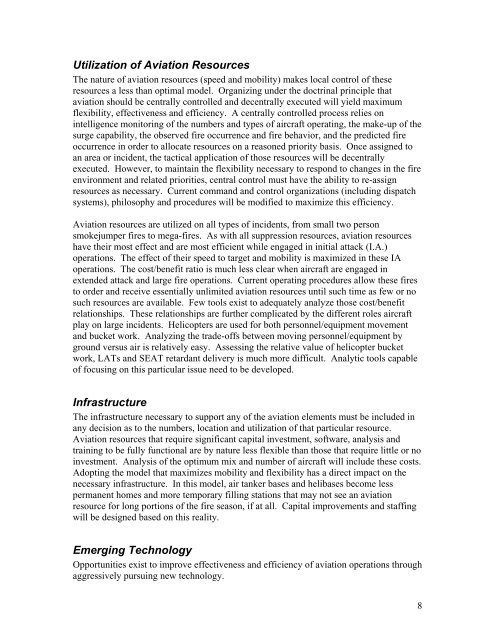Interagency Aviation Strategy - July 2008 - National Wildfire ...
Interagency Aviation Strategy - July 2008 - National Wildfire ...
Interagency Aviation Strategy - July 2008 - National Wildfire ...
You also want an ePaper? Increase the reach of your titles
YUMPU automatically turns print PDFs into web optimized ePapers that Google loves.
Utilization of <strong>Aviation</strong> Resources<br />
The nature of aviation resources (speed and mobility) makes local control of these<br />
resources a less than optimal model. Organizing under the doctrinal principle that<br />
aviation should be centrally controlled and decentrally executed will yield maximum<br />
flexibility, effectiveness and efficiency. A centrally controlled process relies on<br />
intelligence monitoring of the numbers and types of aircraft operating, the make-up of the<br />
surge capability, the observed fire occurrence and fire behavior, and the predicted fire<br />
occurrence in order to allocate resources on a reasoned priority basis. Once assigned to<br />
an area or incident, the tactical application of those resources will be decentrally<br />
executed. However, to maintain the flexibility necessary to respond to changes in the fire<br />
environment and related priorities, central control must have the ability to re-assign<br />
resources as necessary. Current command and control organizations (including dispatch<br />
systems), philosophy and procedures will be modified to maximize this efficiency.<br />
<strong>Aviation</strong> resources are utilized on all types of incidents, from small two person<br />
smokejumper fires to mega-fires. As with all suppression resources, aviation resources<br />
have their most effect and are most efficient while engaged in initial attack (I.A.)<br />
operations. The effect of their speed to target and mobility is maximized in these IA<br />
operations. The cost/benefit ratio is much less clear when aircraft are engaged in<br />
extended attack and large fire operations. Current operating procedures allow these fires<br />
to order and receive essentially unlimited aviation resources until such time as few or no<br />
such resources are available. Few tools exist to adequately analyze those cost/benefit<br />
relationships. These relationships are further complicated by the different roles aircraft<br />
play on large incidents. Helicopters are used for both personnel/equipment movement<br />
and bucket work. Analyzing the trade-offs between moving personnel/equipment by<br />
ground versus air is relatively easy. Assessing the relative value of helicopter bucket<br />
work, LATs and SEAT retardant delivery is much more difficult. Analytic tools capable<br />
of focusing on this particular issue need to be developed.<br />
Infrastructure<br />
The infrastructure necessary to support any of the aviation elements must be included in<br />
any decision as to the numbers, location and utilization of that particular resource.<br />
<strong>Aviation</strong> resources that require significant capital investment, software, analysis and<br />
training to be fully functional are by nature less flexible than those that require little or no<br />
investment. Analysis of the optimum mix and number of aircraft will include these costs.<br />
Adopting the model that maximizes mobility and flexibility has a direct impact on the<br />
necessary infrastructure. In this model, air tanker bases and helibases become less<br />
permanent homes and more temporary filling stations that may not see an aviation<br />
resource for long portions of the fire season, if at all. Capital improvements and staffing<br />
will be designed based on this reality.<br />
Emerging Technology<br />
Opportunities exist to improve effectiveness and efficiency of aviation operations through<br />
aggressively pursuing new technology.<br />
8
















